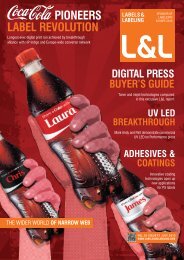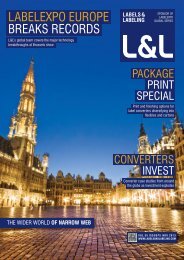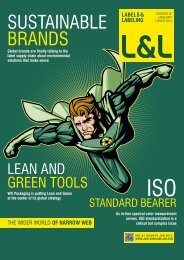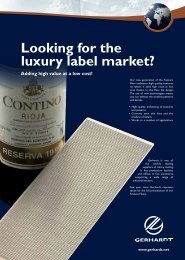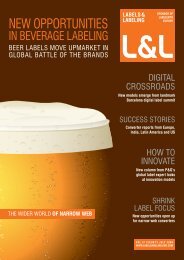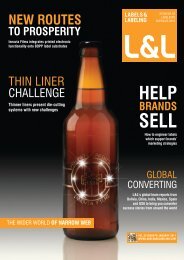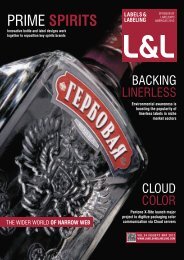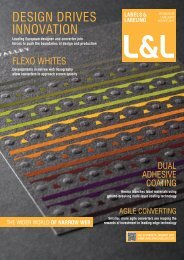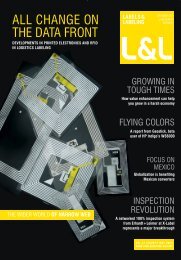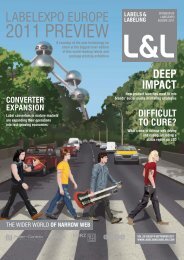You also want an ePaper? Increase the reach of your titles
YUMPU automatically turns print PDFs into web optimized ePapers that Google loves.
LABELS&LABELING |21<br />
Sustainability and performance<br />
from stretch sleeve labels<br />
THE LATEST DEVELOPMENTS IN STRETCH SLEEVE LABELS offer exciting new options to address<br />
environment and sustainability issues, are highly efficient, and provide a rapid return on investment. Mike<br />
Fairley reports on the new Triple S sleeves introduced by CCL Labels<br />
Look at any of the recent market studies on the size and growth<br />
of the label industry and it soon becomes clear that one of the<br />
fastest growing label technologies over the past few years has<br />
been sleeve labels. Latest estimates give sleeves around a 12<br />
percent market share out of a total global label market of 76<br />
billion US dollars.<br />
Yet this figure is perhaps misleading. Sleeves are more than<br />
just a label that competes with other types of labeling. They can<br />
also compete with direct printing in some cases; they do offer<br />
360 degree decoration, but so does wrap-around film or even<br />
glue-applied labels; they can provide tamper-evidence and<br />
security sealing, but then so does self-adhesives.<br />
What sleeves do offer that is different to most other types of<br />
labeling and decoration is a cost-effective method of decorating<br />
highly complex shaped containers. They may also enable the<br />
wall thickness of plastic containers to be reduced, eliminate<br />
the need for colored containers, and provide new types of<br />
promotional opportunities. Such benefits mean that sleeves have<br />
often become a first choice for new product launches.<br />
They are able to achieve these benefits through the sleeve<br />
conforming tightly to the container shape. Traditionally this has<br />
mainly been obtained by using a shrinkable film which has<br />
been pre-printed on a gravure or flexo press. The web is then<br />
formed into a tube, cut to size and placed over the container, and<br />
then passed through a steam, hot air or infra-red shrink tunnel,<br />
enabling the film to shrink to the container shape and provide a<br />
high quality decorated bottle or container.<br />
Historically dominated by PVC shrink films, which in many<br />
markets have been increasingly faced with environmental<br />
considerations, new types of non-PVC shrinkable films have<br />
come into common use, including PET/PETg, PLA and OPS<br />
– which, in turn, can provide a challenge when recycling PET<br />
bottles.<br />
Using the water separation technique which is commonly used<br />
in Europe and the USA, the shrink sleeve material needs to have<br />
FIGURE 2. CARBON FOOTPRINT OF A TRIPLE S STRETCH<br />
SLEEVE COMPARED TO A CONVENTIONAL SHRINK SLEEVE<br />
SHRINK<br />
n PRODUCTION<br />
n WASTE AND RECOVERY<br />
n TOTAL CARBON FOOTPRINT<br />
TRIPLE S SUPER STRETCH<br />
FIGURE 1: EXAMPLE OF TRIPLE S STRETCH SLEEVE<br />
PROVIDING LESS FILM WEIGHT PER SLEEVE WHEN<br />
COMPARED TO A SHRINK SLEEVE<br />
SHRINK SLEAVES<br />
TRIPLE S<br />
a specific gravity below one so that the material floats on<br />
the water while the PET bottle flakes sink to the bottom of<br />
the tank. The non-PVC materials mentioned above all have<br />
specific gravities of about 1.25 to 1.4.<br />
Such recycling challenges, particularly the need to<br />
meet the latest European PET Bottle Platform Guidelines,<br />
combined with other environmental pressures such as the<br />
need to reduce film usage – both in volume and weight,<br />
reduce the significant energy usage found in shrink tunnels<br />
and eliminate glue usage, have led to a growing interest and<br />
usage of alternative forms of sleeving, such as the Triple S<br />
stretch sleeve label option introduced by CCL Label, Austria.<br />
Instead of taking an oversize shrinkable PVC, PET, PLA<br />
or OPS printed film tube and shrinking it to a tight fit using<br />
a shrink tunnel, the Triple S sleeve technology takes an<br />
LDPE printed film tube and stretches it over the bottle or<br />
container. It then contracts to guarantee a tight fit without<br />
any need for an energy-intensive shrink tunnel. It therefore<br />
uses less film and requires no shrink<br />
tunnel – potentially more than 50<br />
percent like-for-like weight reduction<br />
per sleeve label. This can be seen in<br />
Figure 1.<br />
Being a stretch film option, the film<br />
is also able to expand or contract with<br />
the bottle (an important requirement<br />
for carbonated beverages), is ideal<br />
for squeezable bottles, and always<br />
fits tightly and perfectly flush. Not<br />
being heat sensitive, the stretch<br />
sleeving operation helps to stabilize<br />
and counteract bottle distortion, or<br />
‘belly-drop’ which is common with<br />
hot-filled containers.<br />
What’s more, the LDPE stretch<br />
film used has a low density (0.91<br />
gr/ccm) allowing easy and cleaner<br />
JULY 2012 | L&L



